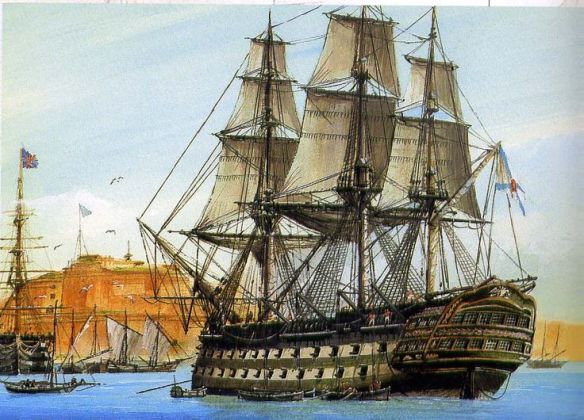Azov in Valletta, Malta.
Azov is a large ship on the left of the Battle of Navarino painting by Ivan Aivazovsky.
Azov was a 74-gun ship of the line of the Imperial Russian Navy. Azov was built in 1826 to compensate the losses of the disastrous 1824 Saint Petersburg flood. In the same year Azov, commanded by Mikhail Lazarev, became the flagship of Admiral Login Geiden’s First Mediterranean Squadron and sailed to the Aegean on a joint English-French-Russian peacekeeping mission. On October 20, 1827 Azov spearheaded the Russian squadron into in the Battle of Navarino. She engaged numerous enemy ships and sustained heavy damage.
After refit at Malta Azov continued her service as Geiden’s flagship and enforced naval blockade of Greece and the Dardanelles. In the beginning of 1830 Azov returned to Kronstadt. By this time the ship was literally rotten owing to poor workmanship and combat damage. She was retired in the same year and broken up in 1831 after only four years in service.
Five officers of Azov who fought at Navarino became admirals in the Russian Navy: captain Mikhail Lazarev, Vladimir Istomin, Vladimir Kornilov, Pavel Nakhimov and Yevfimy Putyatin.
Battle of Navarino
At about 11 a.m. of October 20 [O.S. October 8] a change of wind allowed Codrington to order the move into the harbor. It was agreed that the English and Russian squadrons enter the harbor in parallel lines, followed by the French. At about 1 p.m. Codrington, cautious about the narrow entrance into the harbor, changed the plan and signaled orders to take formation in a single line. The allied fleet took position in an arc side-by-side with the Turkish fleet. Azov headed to its planned position at the very center of the allied arc, with the rest of the Russian fleet to its port, the English and French battleships to its starboard, and the English frigates in the rear. Soon the Turks fired at a British cutter, killing lieutenant Fitzroy and igniting an all-out naval battle. Sources disagree on exact timing of events owing to different timekeeping practices and the confusion of the battle; the first shots were marked at either 2:00, 2:20 or even 2:45 p.m.; ship log of Azov recorded them at 2:30. At this moment Azov was still on the move to its planned station and had just escaped the firing range of Turkish coastal artillery. The smoke of English-Turkish shootout obstructed their view to starboard; Azov fired its first shots to port at 2:45.
At 3 p.m. Azov reached its destination, folded her sails and dropped her anchors. Lazarev intended to fight next to HMS Albion, the leftmost ship of the British squadron. To evade heavy smoke that completely blocked the view, Azov dropped anchor to the port of its place in the line. The maneuver created a gap between Azov and Albion, wide enough to fit four Turkish frigates. Eventually they encircled Azov and Albion and both ships suffered abnormally high damage. Geiden noted that for a certain 22-minute interval Azov was engaged by eight enemy ships.
Although Azov was taking hits from different enemy ships, Lazarev concentrated his gunfire on a single target, a 76-gun ship of the line that had earlier engaged Albion. By 3:30 p.m. the enemy ship lost all masts and dropped out of the line. The gap was filled by a two-deck frigate under the flag of Tahir Pasha. At about 4:00 p.m. another frigate, moored next to Tahir’s flagship, exploded and disrupted the enemy line of battle. A sudden opportunity allowed Azov to fire both broadsides at point-blank range, and in a short time she sank two frigates and a corvette. Still, Azov remained in an extremely dangerous position. At 4:30 it was relieved by the arrival of the French Breslau, which filled the gap between Azov and Albion and whose first salvo destroyed an Egyptian frigate that fired at Azov. For the remainder of the battle Azov and Breslau fought together, engaging enemy ships one by one. Tahir’s frigate returned fire until at least 5:30 p.m. and managed to knock down Azov’s third mast; it lost five out of six hundred men and was abandoned. Shortly before 6 p.m. Azov ceased fire: all enemy ships within its reach were destroyed or forced to beach.
Azov’s own losses (24 sailors killed, 6 officers and 61 sailors wounded) were the highest among the Russian ships. Likewise, the English and French flagships suffered the highest casualties of their squadrons.
